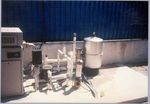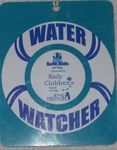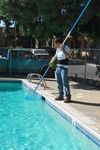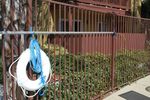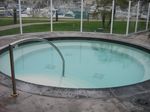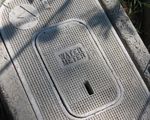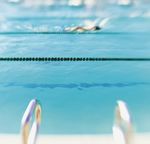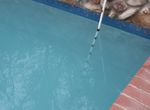Swimming Pool Operator's Guide - County of San Diego Department of Environmental Health Food and Housing Division
←
→
Page content transcription
If your browser does not render page correctly, please read the page content below
Swimming Pool
Operator’s Guide
1st Edition
County of San Diego
Department of Environmental Health
Food and Housing DivisionAcknowledgements
National Swimming Pool Foundation
Centers for Disease Control
Consumers Product Safety Commission
National Drowning Prevention Alliance
American Red Cross
San Diego County Aquatic Council
Association of Pool & Spa Professionals
Independent Pool & Spa Service Association
Safe Kids
Department of Environmental Health, Pool Think Tank MembersTable of Contents Introduction Chapter 1 The Inspection Report 1 Chapter 2 Water Chemistry 2 Chapter 3 Entrapment 3 Chapter 4 Recirculation / Filtration / Disinfection 4 Chapter 5 Chemical Storage 6 Chapter 6 Safety Hazards 7 Chapter 7 Enclosures / Security 11 Chapter 8 Water Clarity 14 Chapter 9 Maintenance and Operations 15 Appendix A Drowning Prevention 22 Appendix B Suction Entrapment Prevention 25 Appendix C Recirculation / Filtration / Disinfection 28 Appendix D Water Chemistry and Testing 35 Appendix E Routine Maintenance 43 Appendix F Common Reasons for Pool Closures 45 Appendix G Pool Water Contamination and Response Guidelines 47 Appendix H Disaster and Emergency Response 50 Appendix I Recreational Water Illness (RWI) Prevention 57 Appendix J Permits and Plan Check Requirements 59 Appendix K Formulas, Conversions and Calculations 60 Appendix L Contact Information 65 Appendix M Forms and Applications 67 Glossary 74 Notes 79
INTRODUCTION The purpose of this guide is to provide public pool owners and operators with an understanding of how their pool is permitted, inspected and regulated by the Department of Environmental Health. It also provides general information about the proper operation and maintenance of a public pool. The Department of Environmental Health (DEH) Swimming Pool Program is designed to eliminate illness, injury and death at public pools by reducing risk factor violations. The Swimming Pool Inspection process focuses on these “risk factor violations”. The following RISK FACTOR VIOLATIONS have been identified as leading to injury, illness or death: Improper water chemistry Unsafe suction outlets Improper recirculation / disinfection system Improper chemical storage Safety hazards Unsecured pool enclosure Inadequate water clarity The pool owner/operator can control these risk factor violations by taking the following ACTIONS or INTERVENTIONS: Designate a person responsible for the pool and bathers Train staff Educate bathers Keep maintenance, operation and training records and logs Review maintenance, operation and training records and logs Supervision is the key to the success of these interventions and the safe operation of the facility. The pool must be under the supervision of a person who is fully capable and will assume responsibility for compliance with all requirements relating to pool operation, maintenance and safety. The California Health and Safety Code requires that every pool have a responsible person to take appropriate action to correct hazardous conditions at the pool. Every pool should be monitored for unsafe conditions that could lead to injury, illness or death. These hazards could include something as common as broken glass in the water, to something as rare as a car crashing into the pool. DEH strives to develop partnerships with each pool owner/operator. By working together, we can provide safe, well-operated and well-maintained public pools for the enjoyment of everyone.
CHAPTER 1 THE INSPECTION REPORT
The Environmental Health Specialist (EHS) uses the Pool Inspection Report to record
observations and violations found during an inspection. The Pool Inspection Report is a tool
used to evaluate the safety and operation of your pool facility. At the end of an inspection, the
EHS reviews the results of the inspection and explains any actions required to correct
violations. You are encouraged to maintain a copy of the inspection report for your records.
The EHS works with the pool operator to gain voluntary compliance whenever possible.
However, it is important to know that the violations listed on the Pool Inspection Report are
violations of the California Health and Safety Code, California Code of Regulations, California
Building Code and California Electrical Code. These violations require correction. Immediate
health hazards observed must be corrected during the inspection or will result in closure.
The inspection report is divided into four general sections: Risk Factors, Maintenance &
Operations, Measurements & Readings and Observations & Corrective Actions.
RISK FACTORS: This section covers water
chemistry, entrapment, recirculation system,
disinfection system, chemical storage, safety
hazards, enclosures/security, water clarity and
other unsafe conditions.
MAINTENANCE & OPERATIONS: This section
covers items that are important in maintaining the
pool, but are usually not an immediate threat to
the safety of the bathers or staff.
MEASUREMENTS & READINGS: This section is
used by the specialist to record chemical test
results and readings taken from the equipment
gauges and meters during an inspection.
OBSERVATIONS & CORRECTIVE ACTIONS:
This section provides space for the specialist to
note observations, clarify violations and explain
corrective actions.
The REVERSE side of the inspection report lists
the general requirements for each numbered item
with applicable state and local codes.
1CHAPTER 2 WATER CHEMISTRY
Sanitizer
The minimum level for unstabilized free chlorine is 1.0 ppm and 1.5 ppm for stabilized
free chlorine. When bromine is used as sanitizer, the minimum concentration required is 2.0
ppm. The maximum level for both free chlorine and bromine is 10.0 ppm. Sanitizer is
responsible for killing pathogens that can cause illness. A minimum concentration of
sanitizer must be maintained in the pool. If the sanitizer concentration is not in the approved
range - CLOSE the pool and adjust the concentration to approved levels.
pH
The approved pH range is 7.2 - 8.0. pH is the measure of acidity of the pool water. It is
important in controlling water balance and effectiveness of sanitizer. If the pH is not in the
approved range - CLOSE the pool and adjust the pH to the approved range.
Total Alkalinity
Maintain total alkalinity between 60 - 180 ppm. Total alkalinity is a measure of the ability of
pool water to resist changes in pH. Testing for total alkalinity is not required by current code,
but is recommended as an aid in controlling pH levels.
Cyanuric Acid
Maintain cyanuric acid levels at or below 100 ppm. Cyanuric acid is a chemical that is
commonly referred to as a “stabilizer”. When added to the pool water, it slows the degrading
effect of sunlight on chlorine. In a pool exposed to sunlight the level of cyanuric acid should
be kept between 30 - 50 ppm but must not exceed 100 ppm. As cyanuric acid levels in a pool
increase, the sanitizing power of chlorine decreases.
WATER CHEMISTRY GUIDELINES
See Appendix D “Water
Chemistry & Testing” for Ideal Minimum Maximum
Chemical Pool Type
more information about (ppm) (ppm) (ppm)
Water Chemistry. Free Pool & waterpark 2-3 1* 10
Chlorine Spa & wader 3-5 1* 10
Bromine All 4-6 2 10
pH All 7.4 - 7.6 7.2 8
Cyanuric
Acid
All 30 - 50 0 100
Total All 80 - 120 60 180
Alkalinity
* If a pool uses cyanuric acid, the minimum chlorine concentration is 1.5 ppm
SAFETY TIP! Test pool water daily and record results on a log sheet. Be sure to test for Free
Chlorine by using a DPD test kit.
2CHAPTER 3 ENTRAPMENT
Suction Outlet Covers/Fittings
Entrapment accidents are one of the most preventable causes of injury and death in
swimming pools. For that reason, it is important to closely inspect the suction system of your
pool. All main drain covers must meet the “Virginia Graeme Baker Pool and Spa Safety Act”
(VGB) anti-entrapment standards ASME/ANSI A112.19.8. Main drain covers must be in good
repair and securely attached to the main drain housing. If the covers are broken, loose or
missing - CLOSE the pool and replace the broken cover(s).
Bathers, especially young children, can become entrapped by powerful suction at
unprotected pool or spa main drains or other suction ports in the pool. See Appendix B
“Suction Entrapment Prevention” for more information about anti-entrapment
requirements.
Anti-entrapment Devices or Systems
Pools and spas with single blockable drains or multiple drains less than 3 feet apart are
required to provide an additional layer of anti-entrapment protection. This must be achieved
by one of the following approved systems or devices: Safety Vacuum Release System
(SVRS), a suction limiting system, a gravity drainage system or an automatic pump shut-off
system. If the anti-entrapment device is broken or missing - CLOSE the pool and
repair/replace the anti-entrapment device. For more details on these systems or devices,
see Appendix B “Suction Entrapment Prevention”.
Safety Tip! Use your 12 foot reaching pole to check
that the main drain covers are securely attached.
3CHAPTER 4 RECIRCULATION / FILTRATION /
DISINFECTION
Minimum Turnover Requirements
Each pool must meet a minimum required turnover time. The function of the recirculation
system is to filter contaminates and sanitize the pool water. When it is not working correctly,
the pool water can quickly become dirty and lack adequate germ killing disinfectant. The
turnover time is determined by the size (volume) of the pool, the type of pool and the date it
was constructed. Check the table below to find the minimum turnover time required for your
pool.
Type of Pool Built before Built after
January 1, 1982 January 1, 1982
Swimming 8 hours 6 hours
Wader 2 hours 1 hour
Spa 1 hour ½ hour
Wave N/A 2 hours
Spray pad N/A ½ hour
Turnover Rate (hrs) = Pool Volume (gal) ÷ Flow Rate (gal/min) ÷ 60 (min/hr)
Steps for determining the minimum turnover for your pool:
o Determine date the pool was constructed
o Calculate the volume of the pool (See Appendix K “Formulas, Conversions &
Calculations”)
o Determine the flow rate by reading it from the flow meter
Proper Continuous Operation of Recirculation &
Filtration System
The pool’s recirculation or filtration system is required to be operating during the hours the
pool is open and available to bathers. It is highly recommended that it operate an additional
two (2) hours before and two (2) hours after the pool operating hours. This will allow the pool
filter to clean and sanitize the water without bathers in the water. If the pool’s
recirculation/filtration system is not functioning - CLOSE the pool and don’t allow bathers to
use the pool until the system works correctly.
Perform daily maintenance on the recirculation/filtration system
of the pool. The water level of the pool needs to be maintained
at the mid-point of the skimmer for optimal filter performance.
Check the filter influent and effluent gauges and backwash or
clean if the difference is greater than 10 psi. Empty the skimmer
baskets and make sure all components (weir flap, float valve,
skimmer basket and skimmer cover) are in good repair and
present. See Appendix C “Recirculation / Filtration /
Disinfection” for more information about these systems.
4Proper Continuous Operation of Chemical Feeders
Chemical feeders (chlorinator, pH adjusting feeder and brominator) are required to be
operating and in good repair during pool operating hours. As with the recirculation system, it
is recommended that the chemical feeders also operate two (2) hours before and after the
pool hours of operation. This will allow the chemical feeders to continue to sanitize and
balance the water chemistry without additional contamination from bathers in the water. If the
pool’s automatic chemical feeder is not functioning - CLOSE the pool and repair the system.
Different forms of sanitizer have various pHs. Liquid chlorine has a high pH around 11, so the
pH may need to be adjusted down between 7.2 and 7.8 with acid through an automatic
chemical feeder. For more details on the chemical systems, see Appendix C
“Recirculation / Filtration / Disinfection”.
Tablet Erosion Feeder – Chlorine
or bromine is dissolved and
injected into the pool water
Liquid Chlorine and Acid Feeders
SAFETY TIP! Due to safety concerns for bathers, do not use floating
chlorinators or place sanitizer tablets in or underneath skimmer
baskets. Place tablets only in approved feeders.
5CHAPTER 5 CHEMICAL STORAGE
Proper Chemical Storage
Improper storage of chemicals could result in fire, explosion, or release of toxic fumes, due to
accidental mixing of incompatible chemicals. Pool chemicals must be stored in a clean, dry,
well-ventilated and secure area that is separated from other chemicals such as paint
solvents, insecticides and fertilizers. Storing incompatible pool chemicals together must also
be avoided due to the risk of severe chemical reactions. For example, chemicals with high
pH (liquid chlorine) should not be stored with chemicals that have very low pH (chlorine
tablets). If the chemicals are not properly stored - CLOSE the pool and correct the storage
issue. For chemical emergencies, contact 9-1-1 and evacuate the area.
Reportable Quantities of Chemicals
The storage of any hazardous material in quantities equal to or greater than 55 gallons, 500
pounds or 200 cubic feet requires a Hazardous Materials Permit. This total includes empty
chemical containers that may be on site. No Hazardous Material Inventory Permit is required
if you have less than these quantities.
For Hazmat information please call (858) 505-6880.
SAFETY TIPS!
o Never store liquid chemicals above or beside chemicals in a solid, powder or
tablet form.
o Read and follow storage instructions on container.
o Be prepared to safely clean up a pool chemical spill.
6CHAPTER 6 SAFETY HAZARDS
Hazards can range from trip and fall hazards, cut and scrape hazards, electrical hazards or
biological hazards.
Decking, Coping, Steps, Gutters & Covers
If the above areas of the pool are not maintained in good repair, accidents and injuries can
occur in and around the pool. Cracked or damaged decking, coping, gutters or steps must be
repaired or replaced. Ladders and handrails must be checked to ensure they are secure and
undamaged.
DECKING is required to extend around the entire perimeter of
the pool, be a minimum of 4 feet wide, constructed with concrete
or like material, be slip resistant, non-abrasive, flush with the
pool coping and unobstructed. This provides adequate space to
walk around the pool and to perform a rescue if needed.
Wood decking and carpeting are not approved as decking
surfaces.
SPA POOL DECK EXCEPTION - A spa pool must have
a minimum of 4 feet of unobstructed decking around at
least 50% of the spa. Half of the perimeter of a spa may
be next to a wall, fence or guard rail if this portion of
decking is one (1) foot or less in width.
EXISTING ENCLOSURE EXCEPTION - If a physical
characteristic (building/stairs) of a site encroaches on the 4 foot deck around an existing
pool, the enforcing agency may allow installation of an enclosure which reduces the pool
deck to less than 4 feet in width.
COPING around the pool is usually a series of bull-
nosed stones that slope away from the pool. This
helps keep the pool clean by directing water on the
deck away from the pool. Coping also functions as a
handhold for bathers and must hang over the pool
wall at least 1 inch, but not more than 2 inches. It is
not to exceed 2 ½ inches in thickness.
LADDERS, HANDRAILS & STEPS are intended to provide bathers with
support when entering or exiting the pool. It is essential that they are in
good repair, securely fastened and steady. Loose or wobbling ladders or
handrails can cause fall injuries; while steps with large cracks or chips can
cause cuts or abrasions.
7GUTTERS are found at large municipal and club pools or older
pools built before 1960. Gutters serve two functions: trap debris
and scum from the surface of the water and provide a
handhold for bathers.
POOL & SPA COVERS
Covers on pools and spas provide real benefit if used correctly. They reduce heat loss and
help conserve energy costs if your pool or spa is heated. They also reduce the amount of
debris and contaminates blown into the pool. However, pool and spa covers also pose a risk
of trapping a bather underneath the cover. Therefore, the pool or spa enclosure must be
locked when the pool cover is in place and the cover must be removed and stored away from
the pool when the pool is open to bathers.
All pool covers must be removed and stored at least 4 feet from the pool or spa when
the pool is open and available to bathers.
Lighting
All pools that allow swimming after dark are required to provide lighting for both the pool and
the surrounding deck area. Ensure pool lighting turns on after sunset to avoid injuries and
accidents due to inadequate visibility around the deck and in the pool. If pool and/or deck
lighting is not provided, the pool must post a sign stating “NO USE OF POOL ALLOWED
AFTER DARK”.
POOL LIGHTING
All pools that allow use of the pool after dark must provide sufficient lighting so that all parts
of the underwater area and swimming surface can be seen with no blind spots. Lighting must
be approved by the Department of Environmental Health prior to installation and use. The
pool lighting system must be equipped with a device that automatically turns on the pool
lights from sunset to sunrise.
8DECK LIGHTING
Pool decking must also be provided with sufficient lighting at all parts of the pool deck so that
anyone walking on the deck can avoid any hazards. Deck lighting must be equipped with a
device that automatically turns on the lights from sunset to sunrise.
Float Line, Depth and Safety Markings Provided
Depth markers, depth marking lines and float line provide bathers with information about how
deep the pool is and where there are dramatic changes in depth. Depth markers, depth
marking lines and float lines should be kept in good condition and replaced if they are
damaged or missing.
FLOAT LINES WITH BUOYS are required for all pools with a
break-in-slope, where the slope at the bottom of the pool gets
steeper causing a dramatic change in depth across a short
distance. The float rope is located on the shallow side of the
break-in-slope, usually at the 4 ½ foot depth.
DEPTH MARKERS are required for all pools and spas and must
be located at each end of the pool and at the deepest and shallowest depth
of the pool.
Numerals must be a minimum of 3 inches in height and of a
contrasting color from the background.
Marker must be made of durable material (tile, plastic or composite material).
Marker must be on the vertical wall of the pool above the water line.
If the pool is greater than 20 feet in width, the depth marker must also
be placed on the edge of the deck next to the pool.
DEPTH MARKING LINES are only required for pools that have
a maximum depth greater than 5 feet. It must be a 4 inch wide
straight line of contrasting color across the bottom of the pool at
the 4 ½ foot depth marker. If the pool is greater than 5 feet deep
and also has a break-in-slope, it is required to provide both a
depth marking line and float line with buoys.
9Spa and Wave Pool Safety
Spa and wave pools present special safety concerns due to their unique features and have
special equipment and signage requirements.
SPA POOLS
Although the warm water and water jets of spa pools can be very relaxing and
enjoyable, they can also be dangerous for some bathers. Exposure to water
temperatures well over normal body temperature can be unhealthy. In addition,
the risk of suction entrapment is greater in spa pools due to the shallow depth
and close proximity of bathers to jet and recirculation suction drains. For these
reasons, all spa pools are allowed to maintain the water temperature at a maximum of 104°F
and to provide an Emergency Shut-Off Switch that shuts off all jets and suction pumps to the
spa. Spa pools are also required to post a SPA CAUTION sign that advises bathers of
dangers related to spa use and a sign adjacent to the Emergency Shut-Off Switch to denote
the switch’s location.
WAVE POOLS
Wave pools are relatively new and offer a unique experience to
bathers who want to enjoy wave action without going to the ocean.
Wave pools generate waves at regulated intervals which changes the
depth of the water dramatically in a short period of time. This change
in depth, together with limited visibility of the bottom of the pool,
poses risks to bathers that are not present at other pools. A system
must sound with an audible signal that warns bathers when a wave is
coming. USCG approved Type II OR III life vests must be made
available for all non-swimmers and children less than 48 inches tall who use the wave pool.
Lifesaving Equipment
All pools must provide the following lifesaving equipment. Ensure that equipment is located in
clear view of bathers and is easily accessible in the event of a rescue.
LIFE RING WITH ROPE
All swimming pools are required to provide a life ring with an
outside diameter of 17 inches and a rope attached that is long
enough to span the widest part of the pool.
12 FOOT POLE WITH BODY HOOK
All pools must provide a 12 foot reaching pole with a body hook
securely attached. The pole should be stored in a location that is
clearly visible and is easily accessible to bathers. A shorter pole
of adequate length to assist a bather in a spa is permitted if the
spa is in an area not large enough to accommodate a 12 foot
pole.
10CHAPTER 7 ENCLOSURES / SECURITY
Enclosure
A well secured pool enclosure is vital to preventing childhood drowning. The fence or wall
(surrounding the pool and decking area) and all gates or doors leading into the pool area are
part of the enclosure. Enclosure requirements depend on when the pool enclosure was
constructed. Pools constructed after July 1, 1994 are regulated by code sections found in the
California Code of Regulations (CCR), Title 24, Chapter 31B, Sections 3118B - 3118B.4. If
the enclosure is broken and children can access the pool - CLOSE the pool and repair the
fencing.
Requirements for pool enclosures constructed or modified after July 1, 1994:
Pools must be enclosed by a non-climbable wall or fence with a minimum height of 5
feet (60 inches) with no openings or gaps greater than 4 inches.
The space between the bottom of
the fence and the ground shall be
no greater than 2 inches, unless
the surface under the fence is a
durable concrete like material in
which case 4 inches is
acceptable.
Horizontal members must be a
minimum of 48 inches apart to
prevent climbing.
Chain link fencing may be used if the open spaces of the
links are not greater than 1 ¾ inches. Any spaces greater
than 1 ¾ inches would be considered climbable.
1 ¾
inches
maximum
Buildings may be part of the enclosure if no doors, gates or windows from dwelling
units open directly into the pool area.
Climbable structures or natural features shall not
be within a 5 foot radius, measured from the top of
the outside of the enclosure.
11Combination Fencing
Combination fencing consists of two or more materials stacked or
integrated to form one solid fence. Commonly, this type of fence
consists of a short masonry (block wall), one to two feet in height,
with a wooden, metal, or chain link fence on top of the block.
One of the components of the wall must be a minimum of four (4)
feet in height and the fencing on top of the wall must be set to the
outside of the wall to prevent climbing.
Requirements for pool enclosures constructed before July 1, 1994:
Pool area shall be enclosed by a wall or fence with
a minimum height of 4 feet (48 inches) with no
opening or gaps greater than 4 inches.
Buildings surrounding the pool may be part of the
enclosure if there are gates and fencing at
entrances to the apartment complex to restrict
direct access to the pool area by non-residents.
Buildings surrounding a courtyard, combined with
fencing and gates at an apartment complex
entrance, can create a swimming pool enclosure.
Modifying Existing Enclosures
Enclosures modified after July 1, 1994 must meet the July 1, 1994 enclosure requirements
for fencing, gates and decking. Contact the DEH plan check unit before installing new fencing
or decking, or making any major modifications to the existing fencing or decking.
Acceptable Construction Materials
Fencing and gates must be constructed out of a durable material such as wood, metal,
masonry, plexiglass, or vinyl. Fencing and gates must be installed so they are stable and
secure. Vegetation such as bushes or shrubbery is considered to be non-durable and
is not approved.
SAFETY TIP! Routinely check all gates to make sure they are self-closing and
self-latching. Also, check that the fencing is secure and in good condition with no gaps
larger than 4 inches.
12Self-Closing & Self-Latching Gates
Pool gates should be checked on a daily basis to ensure they are self-closing and self-
latching. All gates must open out and away from the pool (if constructed after 1994), with the
latch a minimum of 3 ½ feet (42 inches) above the ground. Test the gate by opening to a
minimum of 12 inches and allow to close. If one or more of the pool gates is not self-closing
and self-latching, or is in disrepair - CLOSE the pool and/or secure the problem gate(s)
(chain or lock shut) until gate(s) is repaired.
Gates with Keyless Egress
All pool enclosures constructed after July 1, 1994 must have at least one gate or door
through which a person can leave (egress) the enclosure without a key. Keyless egress gates
or doors must be clearly marked with an “Emergency Exit” sign unless all gates and doors
are keyless.
Lifeguard Service
DIRECT FEE
A facility charging a “direct fee” for the use of a pool (swimming, spa, wader, etc.) to the
exclusion of any other service, facility or amenity, must provide lifeguard service. If there is no
lifeguard on duty - CLOSE the pool until a lifeguard is placed on duty.
WAVE POOL
A lifeguard is required to be present.
LIFEGUARD QUALIFICATIONS
All lifeguards must have current certification from the American Red Cross (advanced
lifesaving certificate), YMCA (senior lifesaving certificate) or have equivalent qualifications as
determined by the California Department of Public Health. They must also have training in
administering first aid, including cardiopulmonary resuscitation (CPR).
REQUIRED NUMBER OF LIFEGUARDS
This is dependent on a number of factors such as how many pools are in the enclosure, how
large are the pools, what kinds of activities are occurring and how many bathers are in the
pools. A general rule of thumb is to have enough lifeguards posted at different locations of
the pool so that they are able to assist a bather in any part of the pool within 10 seconds.
Lifeguards may not perform any other duties (e.g. conduct chemical water tests, teach
swimming lessons, etc.) during the time they are responsible for guarding the pool.
13CHAPTER 8 WATER CLARITY
Poor water clarity is an indication that the water may be unsafe for bathers. Cloudy or
discolored water can mean the pool is contaminated or inadequately filtered. If the water
clarity is so poor that the bottom of the pool is not visible, a potential drowning victim may not
be seen until it is too late to rescue them. Check the water clarity of the pool on a daily basis.
If the main drain cover is not visible through the water - CLOSE the pool and correct the
water clarity.
MAIN DRAIN CLEARLY VISIBLE
The pool main drains must be clearly visible from the deck of the pool.
Poor water clarity is usually the result of contamination, algae bloom, poor filtration or
chemical reactions with metals. Cloudy water can be caused by inadequate filtration,
insufficient water circulation, insufficient flow rate or poor water chemistry.
Not clear
Clear
SAFETY TIP! Check daily to see if you can easily see the main drain covers
from the deck. If the drain is not visible, close the pool until the water clarity
improves.
14CHAPTER 9 MAINTENANCE &
OPERATIONS
WATEA
Pool Shell, Surface & Tiles Clean
Keeping the pool water surface clean of leaves and other
floating debris is important in the daily maintenance of the pool.
The surface should be skimmed daily or as needed depending
on wind and weather conditions. Floating scum, sputum or
other debris must not be allowed to accumulate on the water
surface.
The pool shell (bottom, side walls and tile line) must be
routinely brushed to eliminate algae and dirt buildup. This
Brushing plaster
action will help reduce the demand on the sanitizer
concentration and the need for additional chemical treatments.
Required Signs Posted & Good Repair
All pools and spas are required to post these three (3) signs in plain view from all parts of the
pool enclosure and maintain signs in good repair.
OCCUPANT
o MAXIMUM OCCUPANT CAPACITY CAPACITY
Signage must be in a minimum of 4 inch lettering
Post number of bathers allowed in the pool at one time __21__
Pool Capacity = one bather for every 20 ft2 of surface area
Spa Capacity = one bather for every 10 ft2 of surface area
o ARTIFICIAL RESPIRATION PROCEDURES
Important that this sign is clearly visible and easily
readable from all pools
Clear diagram of CPR and rescue breathing
o EMERGENCY TELEPHONE # (9-1-1)
15Pools may require additional signage depending on the particular type, special features,
activities or equipment used by the facility. The facility may need one or all of the following
signs posted:
o WARNING – NO LIFEGUARD ON DUTY
Signage must be in a minimum of 4 inch lettering
Not required if facility does have a lifeguard on duty
whenever pool is open for use
o NO DIVING ALLOWED
Signage must be in a minimum of 4 inch lettering
Only required if pool is less than 6 feet in depth
o SHOWER BEFORE ENTERING POOL
o USE TOILET BEFORE ENTERING POOL
o SPA CAUTION
Must be posted near the entrance of spa pool
Sign must contain the following language:
CAUTION
1. Elderly persons, pregnant women, infants and those with health
conditions requiring medical care should consult with a physician before
entering a spa.
2. Unsupervised use by children under the age of 14 is prohibited.
3. Hot water immersion while under the influence of alcohol, narcotics,
drugs, or medicines may lead to serious consequences and is not
recommended.
4. Do not use alone.
5. Long exposure may result in nausea, dizziness or fainting.
o SPA EMERGENCY SHUT-OFF SWITCH
Should be adjacent to emergency shut off switch
o NO USE OF POOL AFTER DARK
Signage must be in a minimum of 4 inch lettering at each pool entrance
Required for pools without sufficient lighting for use of pool after dark
o EMERGENCY EXIT
Signage must be in a minimum of 4 inch lettering
Facilities that have fencing/gates constructed after July 1994 must clearly label
the gate that is equipped with keyless egress, unless all gates allow for exit
without use of a key
o DANGER: GASEOUS OXIDIZER CHLORINE
Signage must be in a minimum of 4 inch lettering
Sign is required for pools with chlorine gas
In addition, hazard ID symbol must be posted
16 Signs must be posted on the exterior of the door of where the chlorine gas is
being stored
o LIFE VESTS ARE REQUIRED FOR ALL NON-SWIMMERS AND
CHILDREN LESS THAN 42 INCHES TALL
Required only for wave pools
o ALL CHILDREN LESS THAN 42 INCHES TALL MUST BE
ACCOMPANIED BY AN ADULT TO BE ADMITTED TO THE
FACILITY
Required only for wave pools
o AN AUDIBLE WARNING SIGNAL WILL SOUND 15 SECONDS PRIOR
TO THE NEXT WAVE
Required only for wave pools
o CAUTION: WATER IS RECIRCULATED. DO NOT DRINK
Required only for Spray Grounds
The signs listed below are required to have lettering that is at least 4 inches high. All other
required signs should be readable when standing in front of them.
o MAXIMUM OCCUPANT CAPACITY
o WARNING – NO LIFEGUARD ON DUTY 4 inches
o NO DIVING ALLOWED
o NO USE AFTER DARK
o EMERGENCY EXIT
o DANGER: GASEOUS OXIDIZER CHLORINE
Toilet Facilities, Showers and Drinking Fountains
Keep the pool’s restrooms clean, stocked and in good repair. Dispensers must be stocked
with soap, toilet paper and paper towels (or hand dryer). Hot and cold water (maximum of
110°F if from a mixed faucet) must be available at restroom handsinks. Conduct daily
monitoring of all locker/dressing rooms, restrooms and drinking fountains for cleanliness and
maintenance.
Note: Facilities must provide restrooms for bathers if both living quarters and adjacent
building with restrooms (cabana, clubhouse, recreation center) are more than 300 feet away.
Gauges and Flow Meters
Each pump is required to have a working influent gauge (on top of filter) and effluent gauge
(after filter). If the pressure difference between the two gauges is greater than 10 psi, the pool
filter needs to be backwashed or cleaned. The gauges should be positioned at the same
height for accuracy of measurement.
Each pool is required to have a working flow meter. The flow meter measures the flow rate of
the water through the recirculation system in gallons per minute. Note: It should be positioned
17on a straight length of pipe with minimum distances of 10 times the pipe diameter before the
flow meter and 4-5 times the pipe diameter after the flow meter.
Equipment Area
The area where the recirculation, filtration and disinfection systems are located must be
clean, organized and accessible. This area must have adequate lighting for the safety of the
staff. Do not store non-pool chemicals or equipment in the pump room. Label all pool piping
as to directions of flow and to what pool it belongs to.
Responsible Person
Health and Safety Code requires that every pool must be under the supervision of a person
that assumes responsibility for compliance of all pool operation, maintenance and safety of
bathers.
The owner or permittee of the pool or an appointed agent can be the “responsible person”.
He/she is not required to be at the pool during all hours of operation. However, he/she must
assume responsibility for pool operation, maintenance requirements and the safety of bathers
as required.
It is essential that the Department of Environmental Health (DEH) has accurate contact
information. Without this information, DEH cannot quickly inform you of issues related to your
pool inspection, such as complaints, closures or other issues that require your attention.
Access Provided for Inspection
Routine inspections are unannounced and are conducted during
reasonable hours. If your pool facility does not have staff at the pool
during operating hours, ensure that your contact information is current
so that arrangements for an inspection can be made. Lockboxes have
been provided by the Department of Environmental Health in an effort to
offer better key security and accessibility to the enclosure. The
lockboxes are the property of County of San Diego Department of
Environmental Health.
Lockbox for on-site
key storage
18Adequate Record Keeping
All pool operators are required to keep daily records of the operation of each pool. Records
should include readings of disinfectant residual and pH, as well as maintenance activities,
such as cleaning of the filter and quantity of chemicals used to treat the pool. Exception –
Apartment or condo complexes with less than twenty-five (25) units are required to
record information at least two times per week at intervals no greater than four days.
This exception does not apply to hotels or motels.
The records below should be kept for a minimum of one (1) year.
Daily log of test results for disinfectant and pH
Monthly record of cyanuric acid (stabilizer) if used
Incident report of accidents requiring medical attention
Fecal incidents and remedial treatment
Adequate Test Kit Available
All pools are required to have available an approved test kit capable of measuring the pH,
disinfectant concentration and cyanuric acid (stabilizer) concentration if used. Regular
testing of the water is essential for maintaining safe and balanced water in the pool. Testing
the water is the only way to determine whether chemical adjustments need to be made to
keep the pH and disinfectant in the proper range. Although it is optional, DEH recommends
that the total alkalinity also be regularly tested. Total alkalinity has a dramatic impact on pH
levels.
DISINFECTANT TEST – Test kit must test for free chlorine or free bromine, not total
chlorine or bromine.
pH – Test kit must be capable of measuring a pH range between 6.8 and 8.2.
CYANURIC ACID – Test kit must be capable of measuring cyanuric acid
concentration.
TOTAL ALKALINITY – Test kit should be capable of measuring alkalinity.
Cyanuric Acid test
Free Chlorine test pH test
19OTO vs DPD TEST KITS
When chlorine or bromine is used as the disinfectant, a test kit capable of measuring free
chlorine or bromine residual is required. The reagent must be N,N-diethyl-p-
phenylenediamine or (DPD #1), which turns pink in the presence of free chlorine or bromine.
There are other test kits commonly sold at home improvement stores that use an
Orthotolindine (OTO) reagent, but it is not approved because it measures TOTAL CHLORINE
residual, not FREE CHLORINE. OTO turns yellow in the presence of total chlorine. There are
numerous pool test kits available on the market, but the most important thing to consider is if
the kit is capable of testing free chlorine.
DPD Test kit OTO Test kit
TEST STRIPS are an acceptable alternative to test
kits if free chlorine, pH and cyanuric acid tests
are included on the strip.
See APPENDIX D “Water Chemistry & Testing” for
guidelines on water testing and additional information
regarding test kits.
Pool Area Maintained and Free of Vermin & Animals
All parts of the pool and related pool facilities must be maintained clean, in good repair and
free of liter and vermin. Animals should not be permitted in the pool or pool area with the
exception of “service animals”.
See APPENDIX G “Pool Water Contamination & Response” for guidelines on treating
water contamination due to animals.
Filter
Backwash
Waste Water Disposal Water
All waste water generated by the pool must be disposed to the
sewer with an air gap or other DEH approved manner. Waste
water includes backwash water and water drained from a pool.
Sewer
20Pool Shell Finish Maintained
Whether it is made of plaster, tile or fiberglass, the pool shell (walls and bottom) surface must
be maintained non-abrasive and non-slip. The finish color must be white except for tile lines,
coping, handholds, edges of steps and other approved markings such as lane lines and
depth marking lines. Spa pools may be a light (pastel) color if approved by the DEH.
Resurfacing A Pool Shell
It is time to resurface when the shell shows signs of damage that could cause cuts, scrapes
or other injuries. Plaster surfaces that have cracks and chipping larger than one square foot
require resurfacing. If a fiberglass pool shows any delamination, it must be resurfaced.
Missing or cracked tiles must be repaired or replaced.
The plaster surface of this
pool shows signs of
damage caused by
unbalanced water
chemistry.
Severe delamination of
fiberglass pool surface.
21APPENDIX A Drowning Prevention
This section answers frequently asked questions about drowning and gives some drowning
prevention tips. See Appendix L “Contact Information” for web sites with additional
information.
How long does it take to drown? Time is critical in a drowning
situation. Injury or death occurs when the bather is unable to
breathe, which causes the heart to stop beating, and eventually
causes brain damage. Drowning can occur in as little as one minute.
Who is at greatest risk for drowning? According to
the National Swimming Pool Foundation (NSPF), children
younger than five (5) years old are at the greatest risk for
drowning. People under the influence of alcohol and drugs
are also at a high risk.
Where have the most drowning incidents occurred?
Centers for Disease Control (CDC) estimates that 20% of all
fatal drownings occur in pools and spas. In addition, 66% of
nonfatal drownings also occur in pools and spas.
What can a pool operator do to prevent drownings?
There is no magic solution for preventing childhood drownings. Providing layers of protection
are the most effective way to prevent drownings. Examples of layers of protection are non-
climbable fences with self-closing and self-latching gates, constant supervision and other
safety features like alarm systems or pool safety covers for when the pool is closed.
22DROWNING PREVENTION MEASURES TO CONSIDER
o Constant adult supervision of children is
essential.
o Knowing how to swim is the best way to
protect yourself from drowning, but
swimming lessons do not prevent all
drowning situations.
o Educate bathers about the risks
associated with swimming.
o Check depth of water before entering.
o Do not rely on air-filled or foam toys (water wings, noodles or inner-
tubes) as personal flotation devices to prevent drowning.
o Never swim alone.
o Never attempt to swim beyond your skill level.
o Have staff trained in CPR and the use of Automated External
Defibrillators (AED).
o Trained lifeguards reduce the risk of drowning.
o Forbid bathers to use alcohol or drugs before, or while swimming.
o Ensure that main drain covers are securely in place and not
damaged.
o Ensure that your fencing around the pool is in good repair with no
gaps or openings greater than 4 inches. Gates must be self-closing
and self-latching.
o Doors from clubhouses or buildings
that enter into the pool area should be
self-closing and self-latching.
o Only allow swimming when the water
is clear enough to easily see the main
drain at the bottom of the pool
23WATER WATCHER PROGRAM
What can apartment and condo complexes do to improve supervision at the
pool? Encourage and promote a Water Watcher
program.
What is the Water Watcher program? The
program is based on the fact that a child can drown in
the blink of an eye and that one way to prevent
childhood drowning is to designate a person whose sole
duty and responsibility is to watch the children in the
water during the time they are wearing the Water
Watcher tag.
What is the Water Watcher pledge? When an
adult agrees to be a Water Watcher and wears a Water
Watcher tag, they are pledging to do the following:
o While on duty I agree to maintain constant
visual contact with the children who are in or
near the water.
o I will remain by the water area
until I give this tag to another
adult who agrees to actively
supervise the children.
o I will keep a phone near the
water and will refrain from
drinking or socializing while on
duty.
o In a drowning emergency, I will;
Yell for HELP and
remove the child
from the water.
Call 911 or have
another adult call.
Check the child’s
breathing and pulse.
Start rescue breaths
and/or CPR as
needed.
24APPENDIX B Suction Entrapment
Prevention
Suction entrapment is one of the most dangerous, but
preventable risks associated with swimming pools and spas.
This photo shows what can happen if anti-entrapment
systems are not provided or properly maintained.
What is suction entrapment? Simply stated, it is
when any part of a person’s body or clothing becomes
sucked into a main drain or other suction outlet of a pool.
This can include a person’s hair, skin, bathing suit or
jewelry. Entrapment can result in major injury and even
death.
How does suction entrapment happen? The
recirculation systems of all swimming pools and spas work
by pulling the water out of a pool and pushing the water
through a filter. The filtered water is then returned to the
pool. The suction required to draw the water out of the pool
is incredibly strong and is focused at the main drain. If the pool is not equipped with approved
anti-entrapment devices or systems, the pool can become a suction entrapment hazard.
What is the history of suction entrapment prevention regulations?
The state of California has recognized the risk of suction entrapment for more than 25 years.
In 1982, the state required that all newly constructed pools must have a split main drain.
Later, the state required that all wading pools retroactively install split main drains. Then in
December of 2007, the Federal “Virginia Graeme Baker Pool and Spa Safety Act” (VGB)
required all pools to install split main drains with anti-entrapment drain covers, or provide a
secondary layer of protection if the pool has a single main drain or multiple drains less than 3
feet apart. In January of 2010, the state of California enacted AB1020 which required that all
public pools meet all of the requirements of (VGB) by June 30, 2010 and that pool operators
submit a compliance form to the local health department.
What is an anti-entrapment device or system? An anti-entrapment device or
system is designed to prevent suction forces from holding a person, or their clothing, to a
suction outlet (main drain). These devices or systems must be approved or certified as
effective anti-entrapment devices or systems by a recognized certifying authority.
The primary protection is an approved anti-entrapment drain cover over main drains
that are separated a minimum of three (3) feet by a split “T”.
25DUAL DRAIN WITH SPLIT “T”
This system is specifically designed to prevent attachment of a bather to a drain. When a
blockage (bather’s body) covers one of the drains the suction forces transfer to the other
drain where there is less resistance, and never allows the full suction force of the pump to be
at one drain at any one time.
BODY
3 feet
Secondary layer of protection is required if the pool has a single blockable drain or has
multiple drains less than 3 feet apart. Secondary layers of protection include:
SAFETY VACUUM RELEASE SYSTEM
This device is installed next to the suction pump and has a sensitive pressure gauge that
detects any sudden pressure increase caused by a blockage in the system. When the
blockage is detected, a piston in the device sends air into the suction line, which
instantaneously disables the pump.
SUCTION LIMITING VENT SYSTEM Air
This system employs a vent pipe connected
to the suction line and the atmosphere.
The vent is filled with water when the POOL
system is not blocked. When the main drain
is blocked, water from the vent pipe is
sucked into the pump. The water is PUMP
followed by air from the atmosphere,
causing the pump to lose its prime and
relieve the suction at the main drain.
GRAVITY DRAINAGE SYSTEM
This system uses a collection tank located
between the pool and the recirculation POOL
pump. The pump draws water from the
collection tank and directs it to the filter and
back to the pool. The collection tank gets
water from the pool’s main drain by
Collection PUMP
atmospheric pressure and gravity, which tank
removes the need for direct suction at the
pool.
26AUTOMATIC PUMP SHUT-OFF SYSTEM
This system detects a sudden increase in pressure, usually due to a blockage, and
automatically shuts off the pump. This type of system is similar to the SVRS described above.
How can I tell if I am getting an approved anti-entrapment drain cover? The
2007 VGB law required all manufacturers and retailers to only sell approved anti-entrapment
drain covers. These covers all meet the ASME/ANSI A112.19.8-2007 standard, as required
by VGB. Ensure that the covers installed meet or exceed the total flow requirements of the
pool pump(s).
27APPENDIX C Recirculation / Filtration /
Disinfection
A pool’s recirculation and filtration system (see below) is responsible for moving the water
through a disinfection cycle. The pump draws the water through the main drains and
skimmers of the pool into the filter, where dirt and debris are removed. If the water is heated,
it is passed through the heater next, and then to a sanitizer system where the water is
disinfected and then returned back to the pool. The pool’s recirculation, filtration and
disinfection system must be operating and in good repair during the pool’s hours of operation.
PRESSURE
HEATER FLOW METER GAUGES
AUTOMATIC
TIME CLOCK FILTER
CHLORINATO
R
PUMP
This section provides a brief and general description of the components of a recirculation,
filtration and disinfection system of a 30,000 to 40,000 gallon swimming pool. It discusses
the different types of filters and disinfection systems that are commonly used in San Diego
County.
Contact DEH Plan Check Unit when installing, modifying or replacing any
recirculation equipment.
Pump
The pump’s function is to move the pool water through the
recirculation system (i.e. strainer, filter, heater, disinfection).
28How does a pump work? The pump has a suction side and a pressure side. Suction is
created by the centrifugal force generated by the spinning of an impeller, which is turned by
an electrical motor. The suction draws water from the main drains and skimmers into the
pump. After water passes by the impeller, it is pushed by pressure through piping to the filter,
heater, disinfection system and back to the pool via the return inlets. For larger pools, return
inlets may be located on the bottom of the pool, in addition to the side walls. This provides
better distribution of water in large pools.
Are there different types of pumps, and if so, which one should I use? Yes,
there are two types of pumps commonly used. The most common type is a self-priming
pump, designed to prime itself if air gets into the system. Self-priming pumps are required if
the pump is located above the pool’s water level. The second type is referred to as a flooded
suction pump. This pump requires priming if air gets into the system. These pumps are used
when the pump is located below the pool’s water level.
Does it matter what size pump I use? Yes, all pumps must be sized correctly. When
your pump needs to be replaced it must be replaced with a pump sized properly for your pool.
The pump must be certified by a nationally recognized institution, such as the National
Sanitation Foundation (NSF). NSF certification is often void when only the pump motor is
changed. Check with the manufacturer for proper replacement parts. You can contact the
DEH Plan Check Unit with any questions.
What can happen if the pump is not the right size? If the pump is too small, it will
not move enough water per minute. This will result in ineffective filtration and poor water
quality. If the pump is too large, the water will move too fast through the filter, causing
ineffective filtration. The increased friction may also cause damage to the filter and/or piping.
What about the new technology in pumps? Variable speed pumps are being
required on residential pools to save on energy. Some of these pumps come with safety
vacuum release systems (SVRS) built in. The use of these pumps on public and commercial
pools present problems. The pump has to be set to maintain the required turnover rate during
hours of use. The highest setting cannot exceed the design capacity of the pool plumbing.
The DEH Plan Check Unit has additional requirements for the use of variable speed pumps.
Contact the department prior to making any changes.
Filter
The filter is responsible for cleaning the pool water by trapping dirt and debris. The three
basic types of filter media commonly used are sand, diatomaceous earth (D.E.) and cartridge
filters.
Which filter media is best? Each type of filter media provides different benefits so it
depends on the specific needs of the pool.
What are the characteristics of each type of filter media?
Sand filter is the oldest type of filter and requires the least amount of routine
maintenance. There are two types of sand filter systems:
29o Rapid-rate is not commonly used today and is only found at older facilities.
Rapid-rate uses a course grade of sand on top of a layer of gravel. Due to the
relatively large filter media size, these filters are only capable of filtering
particles larger than 50 microns.
o High-rate is a more modern system using a finer
grade of sand capable of filtering particles larger
than 25 microns.
Both rapid-rate and high-rate sand filters are simple and
inexpensive to maintain. Routine cleaning or backwashing
only requires the turning of a valve to reverse the flow of water
to dislodge dirt and debris trapped between the granules of
sand. The trade off for less time and lower maintenance cost
for routine maintenance is lower water quality and water clarity because a sand filter can only
trap particles larger than 25 microns for high-rate and 50 microns for rapid-rate. Zeolite has
been demonstrated as a material that may be used as a replacement for traditional silica
sand. This material has been shown to filter down to 3 to 5 microns. Check with the
manufacturer for existing sand filters.
Cartridge filter is one of the newest forms of filtration.
Cartridge filters use specially treated paper or polyester
pleated in a cylinder similar in design to an air or oil filter. The
pleating provides a larger surface area to trap dirt and
particles. These filters provide better filtration and water
quality and clarity, but do require more time and money for
cleaning and maintenance. Cartridge filters usually need to be
replaced every six to eight months. Cartridge filters are usually
used on pools with smaller volumes like a spa or wading pool.
They are also considered for pools in rural areas where there
is no sewer for disposing of backwash fluids.
Diatomaceous Earth (D.E.) filters provide the best filtration,
water quality and water clarity due to their capability to filter
particles between 2 to 6 microns. D.E. filter systems consist of a
pressurized canister with 4 to 6 grids of cloth-like covers that
provide filter surfaces on both sides and form the shape of a
leaf. The covers are coated with a fine powder of diatomaceous
earth (tiny skeletons of fossilized plankton). The water pressure
in the filter constantly pushes the D.E. against the leaves
forming a coating that provides an excellent filter. The downside
to D.E. filters is that they require more time and money for
cleaning and maintenance. Each time the filter needs to be
backwashed (about once a week) a new coating of D.E. must be
applied to the filter grids. To ensure effective filtration, the filter
should be disassembled and the filter grids removed, cleaned and inspected for
damage. This should be done every 2 to 3 months depending on pool bather load. The
local sewer district may also require D.E. separators for these filters, especially if the
pool exceeds 2000 square feet. Safer filter media such as Perlite may also be used in
D.E. filters. Check with the manufacturer’s standards.
30 Automatic regenerative media filters are a new line of filters. These utilize what is
known as “bump technology” to reuse the media (typically Perlite).
Meters & Gauges
Meters and gauges are often over-looked and under-utilized by the pool operator. These
instruments provide important information about how effectively the pool recirculation and
filtration equipment are operating. They tell the operator when it is time to backwash the
filters and indicate whether the filter or plumbing is damaged.
Flow meters measure the rate of water flow through the
circulation system in gallons/minute. By knowing the flow rate, the
operator can tell if the water is circulating fast enough to provide
the minimum turnover. Ensure that the appropriate flow meter is
installed at the proper location on a pipe to provide an accurate
reading. For instance, a flow meter designed for 2 inch copper
pipes won’t give an accurate reading if used on 1 ½ inch PVC
pipe. If the flow meter is installed too close to a 90 degree pipe
joint, it will give an inaccurate reading. Follow manufacturer’s
instructions for proper installation of flow meters. Regular cleaning
and maintenance of the flow meter is important to ensure accurate readings. San
Diego County has “hard water” which over time can cause a calcium layer to form
inside the flow meter, causing the flow meter to get stuck. Check the flow meter
routinely.
Pressure filters or vacuum filters have two pressure
gauges: one to measure influent pressure (pressure
inside the filter) and the other for effluent pressure
(pressure outside the filter). As the filter operates, it traps
dirt and debris, which increases the pressure inside
the filter and reduces the pressure outside the filter.
This difference in pressure tells the operator when
the filter needs to be backwashed.
Heaters
The purpose of a heater is to heat the pool water and maintain it at a desired temperature.
The temperature of the water is controlled by a thermostat which automatically turns the
heater on or off depending on the heat demand.
What types of heating systems are available? There are several different heating
systems available. The following are the most common on the market:
Gas Heaters, which are most common, are used to heat small to medium sized
swimming pools or spa pools. Gas heaters heat the pool water by burning either
natural or propane gas as it passes through copper piping within the heater. A
thermostat connected to a thermocouple controls a gas line valve that supplies
additional gas when needed, and closes the gas valve when not needed.
31You can also read

